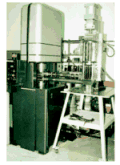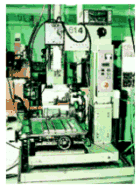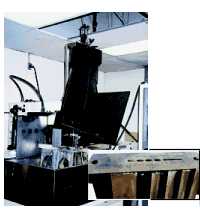Reaching New Heights With Wire EDM
Just how high can you go when it comes to wirecutting tall workpieces? This shop has cut workpieces more than four feet high but workpieces 24 inches high are routine.
When Milt Thomas started his EDM shop in 1978, he had one wire machine and a desk for the programming station, all crammed into a 10 by 10-foot space rented in a friend's machine shop. Appropriately enough, he called his shop the Wire Cut Company. In those days, "you could cut one inch an hour on a wire machine if everything was tuned right," he recalls. Back then, four inches or so was the maximum workpiece thickness on a standard machine.
But even in the early days, Mr. Thomas wasn't so concerned with cutting speed. The challenge that intrigued him was tall workpieces. One of his first customers encouraged him to try to cut a wind tunnel test model. Mr. Thomas modified the arms holding the wire guides so they could clear 9 inches. It worked. Then he upped it to 16, with additional modifications. The customer was delighted.
In the following years, Milt Thomas continued to push the envelope with wire EDM, especially in the area of unusually tall workpieces. The company moved to larger quarters three times, adding new machines and people as it grew. Along the way, wire EDM was evolving at a rapid pace, with each new generation of wire machines exceeding the top speeds, maximum taper angles, and tightest tolerances of the generation that preceded it-often by substantial margins. Wire Cut Company made a point of keeping up.
Today, in a roomy, newly renovated building not far from its first location and practically right around the corner from the Knott's Berry Farm amusement park in Buena Park, California, the company maintains its tradition of doing exceptional work with wire EDM, including some of the tallest workpieces ever cut on a wire machine. The Wire Cut Company now has 14 wire machines, seven ram-type machines, and several small hole EDM drilling machines. See Figure 1. The company employs more than 30 people.
How Wire Works
Despite the rapid development of wire EDM (electrical discharge machining) over the years, the basic process has remained the same. An energized wire gives off electrical discharges, commonly referred to as sparks, that impinge on the workpiece surface. The work-piece must be electrically conductive, but to prevent a short circuit from the wire to the workpiece, deionized water, a dielectric, is forced to flow between them, creating the proper conditions to initiate a discharge. The distance between the wire and the workpiece is often referred to as the "spark gap."
The intense but extremely localized heat generated by each electrical discharge literally boils off a microscopic bit of the workpiece material. Because thousands of discharges occur each second, this process gradually erodes a channel around the wire as it feeds into the workpiece. (EDM is still called "spark erosion" in many shops.) To keep the heat from also destroying the wire, fresh wire from a spool is always being pulled through the workpiece by a wire drive unit.
Even though this is a highly simplified explanation, all of the important process variables can be identified: the nature of the wire, the type of workpiece material, the amount of energy in each discharge, the frequency of the discharges, the pressure of the water flowing in the gap, how fast the length of wire feeds into the workpiece, how fast the wire is pulled through and so on.
Several of these variables have a direct effect on the maximum height of cut, that is, the thickest workpiece that can be shaped with an energized wire. Chief of these is how tightly the wire can be stretched as it is pulled through the workpiece. A wire that resists breaking under tension while defects are being introduced by each discharge is the key.
In the earliest days, Mr. Thomas remembers working with pure copper wire. Copper couldn't be subjected to very much tension (400 to 600 grams at most) without breaking, so it was the limiting factor to how tall a workpiece could be cut. Later, about 20 years ago, when much harder brass wire became practical to use, existing machines could not put enough tension on it to keep it straight. Machine design was the limiting factor.
Later, after redesigned wire tension mechanisms appeared, brass wire coated with zinc or other metals was developed. Zinc requires relatively low vaporization energy, that is, it tends to "boil off" readily during the EDM process. Both faster cuts and taller cuts became possible. These coatings provided enhanced flushing capabilities and, in turn, higher currents could be used for faster cutting speeds without wire breakage.
Wire Cut Company tried them all, learning which was best for each application. The newest wire and one that has benefited the cutting of tall workpieces is a steel-core type. The tensile strength and toughness of this wire is very high, lending it to situations where increased wire tension is required.
Modify, Modify, Modify
There's an old saying among EDM practitioners that the three most important elements to success are flushing, flushing, and flushing. That's still true-efficiently removing the debris produced by the high energy discharges largely determines how competitive the EDM process is with more "traditional" methods of shaping metal. Cutting tall workpieces creates an extraordinary challenge for maintaining adequate flushing. But Milt Thomas would add three other words of advice for tall workpieces: modify, modify, modify.
That certainly has been the pattern at Wire Cut Company and it goes beyond modifications to the wire EDM. This shop has not been afraid to modify other equipment to accommodate unusually tall workpieces. For example, openings within the periphery of a workpiece require a start hole through which the wire can be threaded to start its path. A Sodick EDM hole drilling machine (Figure 2, at left) was modified by installing a riser under the column so the head has an additional 12 inches of Z height.
An Extrude Hone abrasive flow machine (Figure 3, below) has also been arranged so that the abrasive media can be pumped through a series of pipes to reach the top and bottom of tall workpieces. This setup makes it possible to polish the inside surfaces of extrusion dies and other openings in workpieces as tall as 24 inches. When not needed, the diverting pipes are disconnected and the abrasive flow machine can be operated normally.
However, the most significant modifications are those made to the wire machines themselves. Mr. Thomas and his crew are unhesitating when it comes to altering machines so that they can do more than they were intended for.
"The day they come in, I start to saw on them," Mr. Thomas says. Rebuilding or rearranging wire arms is a common modification. Removing sheet metal covers or building new splash guards is typical, too. (Tall workpieces aren't the only kind the shop sees, of course. An alloy ring 30 inches in diameter but only one inch thick is a good example. Most of this workpiece had to be supported outside the machine while notches were wirecut on that portion of the OD inside the work area.)
Other modifications are intended to improve cutting performance under the conditions presented by tall workpieces. These include wire tension systems that go up to 3,000 grams, bigger pumps for higher pressure flushing, floating nozzles that hug closer to the underside of the workpiece, and high efficiency filters.
Even the building Wire Cut Company owns and occupies has been modified for the sake of more accurate, more predictable EDMing. All of the dielectric fluid chillers have been moved to space above the ceiling over the lunch room. Heat exchangers are vented to the outside to keep inside temperature more stable and easier to control.
Because the old rule about "flushing, flushing, and flushing" still holds, a few more words are in order. Mr. Thomas finds that high pressure from the bottom of the workpiece works best because it forces dirt and debris out the top of the cut and away from the lower end of the wire. This is where the wire is most likely to break because it has been exposed in the cut the longest and will have suffered the most degradation.
Steel Core For Toughness
The development of composite EDM wire with a steel core is one of the most significant boosts to EDMing tall workpieces, Mr. Thomas believes. Because wire tension and power settings are both higher when cutting workpieces over 16 inches tall, the EDM wire has to have superior fracture toughness as well as excellent electrical conductivity.
Plain brass was an advance over copper wire. The next big leap was to zinc-coated wire. "We used a whole lot of 0.014-inch, zinc-coated wire for years," Mr. Thomas recalls. "It made wirecutting tall work-pieces practical on a routine basis."
Today, composite wire has replaced zinc-coated as the wire of choice for workpieces 16 inches or taller. The Wire Cut Company uses a composite wire manufactured by Rea Engineered Wire Products (Fort Wayne, Indiana). This wire has a plain carbon steel core that is surrounded by a layer of pure copper and coated on the outside with zinc-enriched brass. Although this wire was developed as a general-purpose problem-solver for a variety of EDM applications, it has proven especially effective cutting tall workpieces or workpieces with other acute flushing limitations. The steel core is both strong and tough, that is, it can be pulled tightly without breaking, and it can also tolerate damage induced by the electrical discharge process.
Of these two qualities, its developers say that toughness, specifically fracture toughness, is the key. Wires with greater tensile strength can be made, but they face diminishing benefits in terms of increased resistance to breakage, and greater tensile strength is usually obtained at the expense of fracture toughness. Fracture toughness, however, does have a real effect on wire breakage. Wire breakages occur most often not because the tension on the wire exceeds the wire's theoretical strength limit, but because the wire suffers microscopic cratering as electrical energy is discharged from its surface.
Fracture toughness is the wire's ability to withstand the formation of craters or pits on its surface, without these defects propagating into wire-breaking fractures. Because of the relatively long time that it takes for wire to pass through a tall workpiece, this exposure to damage increases, thus putting a premium on fracture toughness in this application.
The layer of copper surrounding the steel also helps out in tall cuts. This layer improves conductivity, that is, the ability of electrical energy to flow with less resistance. Higher usable power settings are the benefit. This means faster cutting and a more even distribution of sparks across the length of the wire.
Finally, the zinc-enriched outer coating of brass improves flushability. This layer vaporizes readily, so it creates smaller debris particles when it is quenched by the dielectric. Smaller debris particles are removed more efficiently by the hydraulic action of the high pressure flushing system. The Rea wire has an unusually thick outer coating in proportion to its diameter. Because this coating is sacrificed during EDMing, its thickness determines how long it will last in the cut. In tall workpieces, a thinner layer would be completely consumed before the wire exited the workpiece, minimizing its benefits.
The 48-Inch Machine
Because cutting workpieces as tall as 48 inches is so remarkable, a closer look at the machine the Wire Cut Company uses for this purpose is in order. It is a Charmilles-Andrews EF 630. The machine, one of the last of this type of machine built in the United States, was acquired in 1984. See Figure 4.
Modifications to this machine make it possible to wirecut tall workpieces. The shop fabricated an entirely new upper wire arm machined from 7075 T6 aluminum. Holes were drilled throughout to reduce its weight and minimize droop. The dogleg shape extends the Z axis to 48 inches. The lower arm, in contrast, is stainless steel for strength and rigidity, which are needed to withstand higher forces from increased flushing pressures. The original pumps were replaced with bigger ones that produce twice the flushing pressures. Larger, high capacity filters accommodate the proportionately higher flow of dielectric fluid.
The main advantage of this machine, however, lies in its original configuration as a stationary worktable model. The column and head travel to move the wire in its programmed path. This means large, heavy workpieces can be located partially outside the machine, although an auxiliary table may have to be constructed for support.
Like all of the equipment at Wire Cut Company, this machine has been well maintained over the years and updated regularly. In Mr. Thomas' words, this machine "can cut tall workpieces as fast as any in town." But what about accuracy? On workpieces from 16 to 30 inches tall, his shop holds tolerances of 0.001 inch (0.0005 inch on each side of the wire). From 30 to 40 inches, the shop holds 0.002 inch, and over 40 inches, 0.003 inch.
Tall Tips
Mr. Thomas notes that tall workpieces are likely to be heavy, and heavy workpieces mean heavy "slugs" (the material cut out of an opening, for example). "Handling these slugs is something you have to think about and plan for ahead of time. A slug weighing several hundred pounds isn't going to be pushed out by hand." Typically, holes are drilled and tapped in strategic locations on the workpiece before EDMing. Lift rings can then be installed so a shop hoist can be used to move the slugs.
Another tip: When skim-cutting a tall workpiece, Mr. Thomas recommends fabricating a "sub-tank," or temporary channel of Plexiglas and sheet aluminum, that can be positioned so it surrounds the cutting zone. With water forced up from the bottom and pumped in by auxiliary flushing lines, this sub-tank submerges the entire length of the wire and improves flushing. The Plexiglas allows cutting action to be observed and monitored easily. "On skim cuts, you want to see a blue spark the entire length of the wire. That means cutting conditions are good for a straight, accurate cut and that surface finish will be the same over the full height of the cut," Mr. Thomas notes.
Different workpiece materials lend themselves unequally in tall applications for wirecutting. Aluminum, for example, can be difficult because the metal tends to oxidize during the EDM process. Mr. Thomas finds that keeping flushing pressure high and using a fast wire-reel speed are essential.
Cold rolled steel cuts slowly because of impurities in the material, but 17-4PH and 15-5PH stainless steels do very well, he reports. For low carbon steel, the key is keeping the conductivity of the water low to minimize oxidation. "A tall workpiece may represent two or three hundred hours of cutting time, which is long enough to deplete the ion exchange capacity of the machine's resin bottles, so check them regularly during the cut," Mr. Thomas advises.
Standing Tall
The last and perhaps most important advice Mr. Thomas has to offer is that "if you're going to deal with workpieces that stand tall, you need people in the shop who stand tall. They have to have confidence in their ability to solve problems and be creative. They have to be unafraid to try new things and they have to take pride in meeting tough challenges."
It is certainly fair to say that the Wire Cut Company has that kind of workforce. A workforce like that doesn't walk in off the street, of course. Mr. Thomas is an active supporter of local and state training initiatives and vocational schools. He has helped develop curriculums for EDM training, and students tour his facility frequently to see EDM in action. A number of the shop's current employees came from these programs.
He has an apprenticeship program in place in his own shop. Some of the journeyman tool and die makers who have graduated eventually moved on to start EDM shops of their own. "That's fine," says Mr. Thomas. "We can still learn from each other. And with EDM, everyone is still learning new things it can do."
For more information about EDM wire from Rea Engineered Wire Products, call (219) 421-7446, FAX (219) 421-7448.
To contact Wire Cut Company, call (714) 994-1170.
Related Content
Threading On A Lathe
The right choices in tooling and technique can optimize the thread turning process.
Read MoreChoosing The Right Grinding Wheel
Understanding grinding wheel fundamentals will help you choose the right wheel for the job.
Read MoreChoosing a Five-Axis Machine Tool With Automation in Mind
While much focus is placed on the machinery that moves parts, the features most important for automating five-axis machining are arguably found in the machine tool itself.
Read MoreUnderstanding Swiss-Type Machining
Once seen as a specialty machine tool, the CNC Swiss-type is increasingly being used in shops that are full of more conventional CNC machines. For the newcomer to Swiss-type machining, here is what the learning curve is like.
Read MoreRead Next
3 Mistakes That Cause CNC Programs to Fail
Despite enhancements to manufacturing technology, there are still issues today that can cause programs to fail. These failures can cause lost time, scrapped parts, damaged machines and even injured operators.
Read MoreThe Cut Scene: The Finer Details of Large-Format Machining
Small details and features can have an outsized impact on large parts, such as Barbco’s collapsible utility drill head.
Read More.jpg;maxWidth=970;quality=90)













.jpg;maxWidth=300;quality=90)


.png;maxWidth=300;quality=90)

.png;maxWidth=300;quality=90)
















.jpg;maxWidth=970;quality=90)